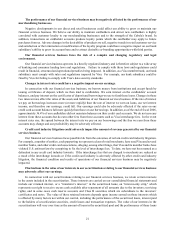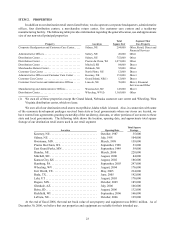Cabela's 2006 Annual Report Download - page 21
Download and view the complete annual report
Please find page 21 of the 2006 Cabela's annual report below. You can navigate through the pages in the report by either clicking on the pages listed below, or by using the keyword search tool below to find specific information within the annual report.17
We must successfully order and manage our inventory to reflect customer demand and anticipate changing
consumer preferences and buying trends or our revenue and profitability will be adversely affected.
Our success depends upon our ability to successfully manage our inventory and to anticipate and respond
to merchandise trends and customer demands in a timely manner. We cannot predict consumer preferences with
certainty and they may change over time. We usually must order merchandise well in advance of the applicable
selling season. The extended lead times for many of our purchases may make it difficult for us to respond rapidly
to new or changing product trends or changes in prices. If we misjudge either the market for our merchandise or
our customers’ purchasing habits, our revenue may decline significantly and we may not have sufficient quantities
of merchandise to satisfy customer demand or we may be required to mark down excess inventory, either of which
would result in lower profit margins. In addition, as we implement our destination retail store expansion strategy, we
will need to construct additional distribution centers or expand the size of our existing distribution centers to support
our growing number of destination retail stores. If we are unable to find suitable locations for new distribution
centers or to timely integrate new or expanded distribution centers into our inventory control process, we may not be
able to deliver inventory to our destination retail stores in a timely manner, which could have an adverse effect on the
revenue and cash flows of our retail business.
A natural disaster or other disruption at our distribution centers or return facility could cause us to lose
merchandise and be unable to effectively deliver to our direct customers and destination retail stores.
We currently rely on distribution centers in Sidney, Nebraska, Mitchell, South Dakota, Prairie du Chien,
Wisconsin and Wheeling, West Virginia to handle our distribution needs. We operate a return center in Oshkosh,
Nebraska, and our Wheeling, West Virginia distribution center also processes returns. Any natural disaster or other
serious disruption to these centers due to fire, tornado or any other calamity could damage a significant portion of
our inventory, and materially impair our ability to adequately stock our destination retail stores, deliver merchandise
to customers and process returns to vendors and could result in lost revenue, increased costs and reduced profits.
Our failure to obtain or negotiate economic development packages with local and state governments could
cause us to significantly alter our destination retail store strategy or format and/or delay the construction of one
or more of our destination retail stores and could adversely affect our revenue, cash flows and profitability.
We have received economic development packages from many of the local and state governments where our
destination retail stores are located. In some locations, we have experienced an increased amount of government
and citizen resistance and critical review of pending and existing economic development packages. This resistance
and critical review may cause local and state government officials in future locations to deny or limit economic
development packages that might otherwise be available to us. The failure to obtain similar economic development
packages in the future for any of these reasons could cause us to significantly alter our destination retail store strategy
or format. As a result, we could be forced to invest less capital in our stores which could have an adverse effect on
our ability to construct the stores as attractive tourist and entertainment shopping destinations, possibly leading to a
decrease in revenue or revenue growth. In addition, the failure to obtain similar economic development packages for
stores built in the future would have an adverse impact on our cash flows and on the return on investment in these
stores.
The failure of properties to generate sufficient taxes to amortize economic development bonds owned
by us that relate to the development of such properties would have an adverse impact on our cash flows and
profitability.
We often purchase economic development bonds issued by state or local governmental entities in connection with
the development of our destination retail stores. The proceeds of these bonds are then used to fund the construction
and equipping of new destination retail stores and related infrastructure development. The repayments of principal
and interest on these bonds are typically tied to sales, property or lodging taxes generated from the related destination
retail store and, in some cases, from other businesses in the surrounding area, over periods which range between
20 and 30 years. However, the governmental entity from which we purchase the bonds is not otherwise liable for
repayment of principal and interest on the bonds to the extent that the associated taxes are insufficient to pay the
bonds. At the time we purchase these bonds, we make estimates of the discounted future cash flow streams they are
expected to generate in the form of interest and principal payments. Because these cash flows are based primarily on
future property or sales tax collections at our destination retail stores and other facilities (which in many cases may
























